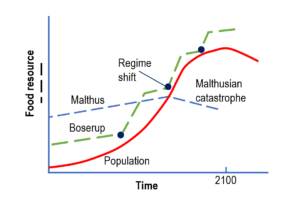Professor Rod Scott is Professor of Plant Molecular Biology in the University of Bath's Department of Biology & Biochemistry.
Thomas Malthus, an English political economist and demographer (who died in 1834, and is buried in Bath Abbey), first addressed the problem of population in his 1798 book An Essay on the Principle of Population. He believed that food production could not keep pace with population growth: “The power of population is indefinitely greater than the power in the earth to produce subsistence for man". The result? A Malthusian catastrophe: starvation and an existential threat to the fabric of society, since the poor majority will suffer most and rebel.
Malthus made an observation that directly connects agricultural innovation and population growth. Numerous improvements in agriculture, even before Malthus’ time, have led to increased food supply – but he saw that these gains were only temporary. They were quickly wiped out by population growth, restoring the per capita production level to the status quo – except, crucially, with an increased population load. The Malthusian trap suggests that humanity inevitably sacrifices prosperity for population growth, or population growth inevitably consumes prosperity.
Of course, the Malthusian catastrophe has not occurred – yet. Nonetheless, conventional agriculture will struggle to keep pace with the demands of a growing and increasingly affluent population in the face of climate change in the decades to come. Genetic modification technologies that have been around since the early 1990s and a suite of powerful new plant breeding technologies (NPBTs) are available to meet this challenge – but the Green Movement, wittingly or unwittingly aided and abetted by the regulators at the European Food Safety Authority (EFSA), is strongly opposed to their use in crop improvement. Why, given scale of the threats we and our planet face, has this alliance fought hard to stifle the use of genetically-modified organisms (GMOs) as crops in Europe, and why does it wish to deal the same blow to NPBT? How could policy be redirected to make better use of this technology? And what benefits are on offer for those willing to grasp the nettle?
The challenge of history
The varieties of plants and animals that provide our food are produced by selective breeding, a process which combines natural or induced genetic variation into particularly effective combinations. Any horticultural seed catalogue demonstrates the power of breeders to create new varieties via this method. In agriculture, recommended seed lists are used by farmers to choose the best-performing varieties of wheat, oil seed rape and so on. The method has worked well, and until recently was reliably adding around 0.9-1.6% annually to the yield of the major cereals – such as wheat, rice and maize – that directly or indirectly (ie. through animal feed) provide the lion’s share of our diet. However, plant breeders are increasingly experiencing yield stagnation; the historically reliable increase in yields are becoming harder and harder to achieve. The fact is that shuffling the pack of genes only creates new combinations, not new variation – and once all combinations have been tried, no further gains are possible.
Since historical yield trends are not sufficient to meet future demand, future crop improvement therefore requires new ways to create genetic variation. GM and NPB technologies are well positioned to make a vital contribution, but they face huge regulatory hurdles – and, certainly in the case of GM crops, hostility bordering on hysteria from the Green Movement and some newspapers. Unsurprisingly, the food supply chain is unwilling to embrace products that a sizeable proportion of consumers is concerned may be both bad for the environment and potentially harmful.
Do the regulatory regime and public perception have a rational basis?
Consider the following scenario. Two plant breeders set out to disable, or ‘knock out’, a gene that normally causes susceptibility to a nasty fungal disease in their plant species. There are various options for doing this. Breeder A chooses mutation breeding: she exposes thousands of seeds to a chemical mutagen or radiation to induce a mutation that knocks out the gene, and searches through the progeny of the treated plants for the rare individual that is no longer susceptible to the disease. Not only does this require a huge screening effort because the method cannot specifically target the gene, but there is also (as one might expect) extensive collateral mutational damage to the rest of the genome that can only be cleaned up by generations of backcrossing to the original, untreated parent – whilst of course always making sure to preserve disease resistance. Although many crop and horticultural plants have benefitted from mutation breeding (the Joint FAO/IAEA Mutant Variety Database lists 3,275 entries in 2018), and some are even certified organic like the barley variety ‘Golden Promise’, there is little doubt that many, perhaps all, retain secondary mutations due to inadequate back-crossing.
Breeder B wants to avoid the shortcomings of mutation breeding, so she chooses genome editing, an NPBT, to knock out the target gene. Genome editing uses a molecular machine comprising a DNA-cutting enzyme and a nucleic acid guide to locate any gene in a genome of any size and introduce a mutation at the predetermined position. The most popular version, CRISPR-Cas9, is derived from the anti-virus surveillance machinery of bacteria. Importantly, the ability to target dramatically reduces the effort required to recover the desired knock-out mutation, and also almost completely avoids secondary mutations – and therefore the need for lengthy backcrossing.
Leaving aside the secondary mutations for now, let us suppose the two varieties created by Breeder A and Breeder B are equally disease resistant and carry exactly the same mutation in the target gene (remember, this could be a ‘one-letter’ change in a genome containing billions of letters). What treatment can the breeders expect from the regulatory authorities before their new varieties can be cultivated and sold to consumers? You might find the answer surprising. In the view of the regulators, Breeder A used a conventional method that does not constitute genetic modification as defined in the EU law and therefore will not require any safety assessment. Breeder B will, if EU regulators get their way, be deemed to have used a regulated genetic modification method – and therefore the new variety will need regulatory approval. This will take a minimum of five years, cost US$7m-$15m and may require animal feeding experiments on large numbers of rats, as well as multiple years of environmental impact assessments.
But why the radical difference, given that the two varieties are identical, except the conventional variety probably carries many additional, unspecified mutations? Put another way, what makes the genome-edited variety a GMO? The answer for EU-based regulators is that, in common with some other NPBT, genome-editing requires a GM step – that is, CRISPR-Cas9 genes are temporarily inserted into the plant and then removed following editing. Although the final plant is free of inserted DNA, any passage through a GMO stage is sufficient for EFSA regulators to consider regulating genome-edited plants as GMOs. This reflects the fact that EU regulation is heavily process, not product, driven. In the US, the opposite is true: regulators at the Federal Drug Administration (FDA), Environmental Protection Agency (EPA) and US Department of Agriculture (USDA) largely disregard the process by which a new plant variety is made, instead focusing on whether the product is substantially equivalent to existing ones. Thus, in the US, neither Breeder A nor Breeder B would face difficulties.
Why does Europe have an irrational approach to the regulation of plant GMOs and potentially NBPT?
Two great influences on European regulation on GMOs have been the Green Movement and the precautionary principle. The precautionary principle, which owes it origins to an approach to risk management captured in aphorisms like "an ounce of prevention is worth a pound of cure” and “better safe than sorry”, is the bedrock of Greenpeace and Friends of the Earth approach to GM; the technology, the act of inserting DNA into a genome by the methods of genetic engineering, is regarded as unsafe, irrespective of the trait specified by the inserted DNA. This explains why the variety produced by our plant breeder using genome-editing is dangerous in their view, and why the US regulatory system based on substantial equivalence does not work for them. The EU has adopted the precautionary principle for environmental protection, and applies it rigorously in regulating GM crops.
It is reasonable that new technologies are evaluated for risk. For GM crops, the relevant areas of risk are to human and animal health through eating food harvested from GM plants, and to the environment as a consequence of the traits carried by the crop – insect and herbicide resistance, for example. The first GM crops were introduced in the early 1990s, and have been grown and consumed on a large scale now for approaching 30 years. Approximately 20% of global farmed land grows GM crops, and in 2017, 19 developing and seven industrialised countries grew GM crops – mostly herbicide- and insect-resistant varieties. More than 90% of US, Brazilian and Argentinian soybeans (the world’s three leading exporters) carry GM herbicide resistance; more than 90% of Indian cotton uses GM insect resistance genes, and China also grows GM cotton and GM rice. In 2014 Bangladesh granted regulatory approval to insect-resistant GM brinjal for direct human consumption. Japan imports virus-resistant GM papaya from Hawaii.
But since large-scale cultivation and consumption of GM crops has been with us for more than 30 years, representing a very high level of exposure of consumers (humans and animals) and the environment to any potential harm, we should be in an excellent position to say whether GM crops are more risky than conventional crops. The answer is a resounding ‘no’; GM crops are not inherently risky. Two reports (2009 and 2016) by the Royal Society concluded that GM crops are safe to eat and present no greater threat to the environment than conventional crops. The World Health Organisation and the US National Academy of Sciences, Engineering and Medicine came to the same conclusion. Significantly, these reports and numerous meta-analyses that compound the data published in multiple peer-reviewed journal papers also find that GM crops benefit farmers in both developed and developing countries through increased yield and profit.
So if the technology has proven safe and effective, has the Green Movement rethought its stance?
Well, no. In fact, this may never happen, irrespective of the evidence. When in 1999 the then Director of Greenpeace, Lord Peter Melchet, appeared before a House of Lords Select Committee on European Communities investigating the regulation of GMOs in agriculture, he was asked:
“Your opposition to the release of GMOs, that is an absolute and definite opposition? It is not one that is dependent on further scientific research or improved procedures being developed or any satisfaction you might get with regard to the safety or otherwise in future?”
He replied: “It is a permanent and definite and complete opposition based on a view that there will always be major uncertainties. It is the nature of the technology, indeed it is the nature of science, that there will not be any absolute proof. No scientist would sit before your Lordships and claim that if they were a scientist at all.”
Whether Green Peace maintains the same absolutist and squarely anti-scientific view of GM technology today is difficult to say, but their opposition persists. Ditto Friends of the Earth.
Using technological overshoot to reverse the environmental impact of agriculture, re-wild farmland and weather climate change
There have been many innovations in agriculture through history – irrigation, the plough, seed drilling, Norfolk four-course crop rotation and new crops from the Columbian Exchange, for example – but nothing comes close to the impact of the Green Revolution of the mid-1960s. During a short period, the global yield of wheat was dramatically boosted by a package of new semi-dwarf and disease-resistant varieties, coupled to plentiful ammonia fertilizer from the Haber-Bosch process and other powerful new pesticides synthesised by a burgeoning agrichemical industry. American agronomist Norman Borlaug, “the father of the Green Revolution”, won the 1970 Nobel Peace Prize for his contributions to world peace through increasing food supply – particularly the supply of wheat in India and Pakistan. The Green Revolution also increased production of rice – and, impressively, it achieved its gains without bringing more land in to cultivation: intensification rather than extensification.
If we assume that GM technologies prove as potent as those of the Green Revolution, then the opposition of the Green Movement can be readily understood: this would mean another regime shift with the potential to fuel population growth, perpetuate the Malthusian trap, and cause yet more damage to an already fragile global ecosystem. However, there are compelling reasons to believe things can be different this time. The downward pressure on population growth brought about by increasing affluence (affluent people have fewer children, on average) and the spread of female rights and education will prevent yield gains turning into more people. The cycle of near bust and boom will be broken; prosperity will not be squandered. This time, any overshoot in output can be used to reduce the impacts of conventional agriculture. Indeed, although the most successful GM traits – herbicide and insect resistance – were designed to increase intensification, they also reduce overall pesticide use, or replace damaging chemicals with more benign ones. As affluence spreads and more countries reach the fifth stage of the demographic transition, the global human population will fall. Couple this to the widespread adoption of sustainable intensification practices and there is the real prospect of reducing the amount of farmland needed, and of returning the surplus to wilderness. This is the most effective way to increase biodiversity.
However, there are two significant challenges to overcome before this can happen. The first is that the contraceptive effect of affluence comes at a price. Affluent people eat more food, but more importantly also dramatically increase their meat consumption. Producing meat requires substantially more land, fertilizer, pesticide, water and energy than producing the equivalent quantity of grain. In the USA, producing 1kg of lamb requires 21kg of grain feed; for 1kg of beef, pork or chicken, the figures are 13 kg, 6kg, and 2.3 kg, respectively. In terms of land, beef requires 27-49m2, depending on the production system, and, pork and chicken requiring 8.9–12.1m2 and 8.1–9.9m2, respectively. Weathering this period of increased demand will require a substantial increase in grain production. The FAO projects that by 2050 demand for cereals will increase by 70%, and will double in many developing countries. This must be achieved in order to reap the environmental rewards of affluence.
The second challenge is climate change. There will be winners and losers in terms of food production. Increased CO2 will boost photosynthesis and productivity in temperate regions, but elevated temperatures will reduce productivity in the tropics and semi-tropics. The areas that lose are already the most highly populated, and where most future population growth is projected. Again, sustainable intensification of agriculture is an essential ingredient in providing food security.
21st Century environmentalism
Environmentalism should therefore embrace, not reject, technologies that increase global GDP, encourage a fair distribution of wealth, and promote women’s education and fertility rights. The Green Movement should recognise the opportunity that increased affluence affords in finally stepping off the Malthusian treadmill, and that people are the solution not the problem – and governmental organisations should follow suit. Innovations in agriculture, such as GM and NBPT, are no longer a threat but essential in first feeding an increasingly affluent population, then reversing the impacts of agriculture, and finally enabling the release of land back to wilderness. The contribution of agbiotech companies like Monsanto should be reevaluated, so that we can avoid throwing the baby out with the bathwater. The Green Movement should encourage regulators to judge GM and NPBT techniques, and in particular products made by these methods, on their merits rather than on the ideologically-motivated precautionary principle.
Caring about the environment means caring about people – this is 21st century environmentalism.
This blog post is part of the Future Policy Challenges series, a new series of IPR Blogs with a focus on science, technology and innovation that highlights some of the crucial issues policymakers may face in the coming years. Subscribe to the IPR blog to get the latest blog posts, or to keep up to date with our activities, connect with us on Twitter, Facebook or LinkedIn. You can also follow the hashtag #FuturePolicyChallenges for more on this series.
Respond





